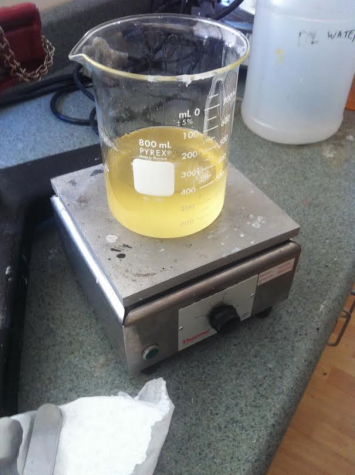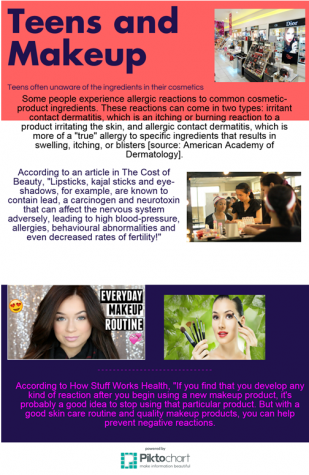Teens often unaware of the ingredients in their cosmetics
Cosmeceutical Research Center internship changes perspectives on cosmetic usage
February 18, 2016
Senior Selin Hartoony said she uses makeup, but not on a daily basis. “I’ve never really paid attention to the ingredients [in my makeup],” she said, “but the makeup brands I use are well known, so I believe they’re trustworthy and safe to use.”
Hartoony’s viewpoint of cosmetic products is typical to many young people who are unaware of the components of the products they are using. “I try to use as little makeup as I can,” Hartoony said. “But when I do put on makeup, I use brands that are well known. I’ve never checked to see if the products I have [used have] been tested on animals before.”
Many people are unaware of the makeup of the products they use. However, I have learned to be more aware of the cosmetic products I use because of a recent internship at Cosmeceutical Research Center in Panorama City that I began in Aug. 2015.
On the first day, I learned about the composition of making a lip balm, as that would be one of the products I would make on my own. The class involved a lot of note taking and hands-on laboratory experience. I began with the notes and gradually got to choose the products I would make.
I started out with lip balm. I had to decide on the type of characteristics I wanted in making my lip balm and had several trials before I got a final product that was glossy and melted at the preferable melting point. “Our skin temperature is around 98.7 Fahrenheit, so keep that in mind,” Dr. Libaridian told me. Dr. Libaridian said that the lip balm should glide when it applied to your lips, but not melt when you leave it in the car during the day.
The products I used for the lip balm included beeswax, cetyl alcohol, octyl palmitate, coconut oil and shea butter. All of the products were separately weighed, combined and heated. Once the lip balm had cooled down, but was still in liquid form, the ingredients were placed into glass jars with pipets.
In one class I learned why we use the beeswax in the lip balm in the first place. Dr. Libaridian said using white beeswax was more common in the industry. “I ordered mine from a company called Herb Products Co.,” he said.

Making of the lip balm.
“Companies will often make colored lip balms, and that is not natural. You want to try to have as organic of a product as possible. Natural products are really important in different cosmetic products as well,” said Dr. Libaridian.
Senior Emmily Hovhannisyan, who wears makeup, said that she pays attention to what she uses on her face. “Products that aren’t good quality will ruin your face or make it break out, so I want to keep my skin as healthy as possible,” she said. “I don’t usually check to see if the products are animal tested, but I probably should, because if I knew it was I wouldn’t use it. Also, I like using makeup that has natural ingredients like cocoa, for example.”
Natural ingredients formed the foundation for my lip balm as well. Dr. Libaridian said that my first trial was good, but the lip balm came out hard. He suggested I decrease the amount of beeswax and add more with the coconut oil and shea butter. In my third trial, I finally got the product the way I wanted.
“Now the fun part is that you can make another batch of your lip balm using the ratios of the products from the third trial and adding the flavoring to the base,” said Dr. Libaridian. I decided on vanilla which is traditional for a lip balm, white honey blossom which is a light smell, and pomegranate for a stronger smell.
Germs do not only come from makeup. We have bacteria in our bodies as well, especially on our hands. As part of the internship, I decided to make hand sanitizer. I started out by learning the use of hand sanitizer. “The best way to clean your hands is washing it, but hand sanitizer is your second option and should definitely not be overused, and the alcohol is the part that kills the bacteria,” said Dr. Libaridian.
The overuse is very true, according to Centers of Disease Control and Prevention, which reported on a Finnish study which showed that after frequent washing of patient-care providers, their skin became damaged and posed a greater risk to themselves and patients than if they had washed less often.
After learning about sanitizers, my assignment was to learn how much bacteria we have in our skin. “We have billions of bacteria on our skin,” Dr. Libaridian told our class. “You have eight thousand per centimeter square, mostly in your forearm and under your armpit, and the bacteria increases more when you do not shower for a day or two.”
After research, I began the process of making my spray hand sanitizer which consisted of ethyl alcohol, glycerin, aloe vera and water. Once again, I had to use the trial and error method to get the correct ratios that would make the product that I wanted. After just two trials, I got it just right. My products were mixed and put into bottles with the spray feature.
Senior Patrick Castro said that he notices that many of his friends use hand sanitizer. “I think, in general, this whole ‘hand sanitizer epidemic’ came from people just being sick and wanting to stay healthy,” he said. “I don’t use it a lot. I stick to the basic water and soap, but if that’s out of reach I’ll go for the hand sanitizer. I don’t think it’s good to use it a lot because for one you start to become obsessed with being clean. While that’s not necessarily a bad thing, you need some bacteria that helps with bodily functions.”
Most experts would agree that not only should consumers be cautious of overuse of hand sanitizer, but people should also pay attention to the ingredients used in makeup. Still, most students interviewed said that they did not pay attention to the composition of the makeup they use. “I’ve never really paid attention to the ingredients, but the makeup brands I use are well known, so I believe they’re trustworthy and safe to use,” said senior Lianna Keshishyan. “I pay attention to the quality of the makeup, but I haven’t really read the back ingredients because it’s all long chemicals.”
Junior Christine Ohanyan, president of the Cosmetic Club at Clark, said that when she speaks to club members she emphasizes that they should not blindly buy products that work for other people. “Everyone is different and will react to products differently,” she said. “ It’s important to take into consideration your skin type, allergies, etc. I also tell them that they should never sleep with makeup on because your skin repairs itself while you sleep and that won’t happen if you have chemicals seeping into your skin.”
